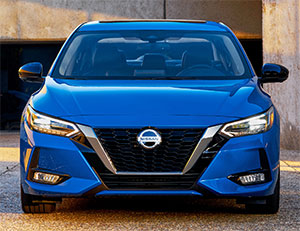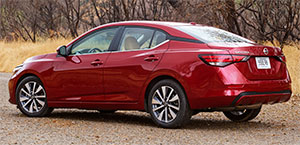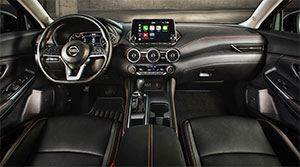2020 Nissan Sentra
Despite many fantastic new options, midsize sedan sales remain in a slump. And, like many things in the auto industry, that trend has started to trickle down to four-door compacts as well; as more and more crossovers gobble up the market. But Nissan has been on a mission to keep the sedan alive and relevant, and now they’ve taken that ethos to a new Sentra.
While most families come into a Nissan dealer to look at vehicles like the Rogue and Pathfinder crossovers these days, there are more Nissan Sentras on the road here in the U.S., than any other Nissan product. 2020 sees the launch of an 8th-generation, and hopes from Nissan to keep the Sentra relevant.
Gorgeous styling will certainly help. Yes, the floating roof design has worked its way through almost all of the Nissan lineup. And it really works here, looking high-shouldered, angular, and ready for the red carpet. We had people guessing everything from a new Maxima to even Mercedes-Benz when they saw it.
 Now granted, a big part of that is also a result of our test car’s Monarch Orange 2-tone paint and SR trim, which brings out the best of the Sentra with 18-inch alloys, dark chrome pieces, LED lighting, black mirrors, and multiple aero treatments.
Now granted, a big part of that is also a result of our test car’s Monarch Orange 2-tone paint and SR trim, which brings out the best of the Sentra with 18-inch alloys, dark chrome pieces, LED lighting, black mirrors, and multiple aero treatments.
The standard engine grows from 1.8 to 2.0-liters, and brings another 25-horsepower with it, taking the I4’s totals to 149-horsepower and 146 lb-ft. of torque. It would have been okay with us to see another 25-horsepower on top of that, but that’s just the way we roll.
And of course, your only transmission option is Nissan’s Xtronic CVT.
Like some other Nissan’s we’ve driven lately, it was a tale of two Sentras at the track.
Acceleration with the naturally-aspirated 2.0-liter is less than thrilling, and the CVT certainly doesn’t like to be launched hard. It’s more of a hesitant lurch off the line rather than a sprint, with 60 miles-per-hour taking 9.1-seconds to achieve.
Lots of engine noise, occasionally lessened by a seemingly random simulated shift, accompanies you the whole way down the track. By the time you reach the end of the ¼-mile in 17.0-seconds flat at 83 miles-per-hour, you’re mostly glad the trip is over.
 Now, the other side of the Sentra revealed itself when we took to our cone course. What a blast! In the compact sedan sort of way anyway. Steering is light, and the car is nicely responsive to inputs. There is a decent amount of body roll, and depending on how aggressive you are, you’ll contend with either over or understeer.
Now, the other side of the Sentra revealed itself when we took to our cone course. What a blast! In the compact sedan sort of way anyway. Steering is light, and the car is nicely responsive to inputs. There is a decent amount of body roll, and depending on how aggressive you are, you’ll contend with either over or understeer.
The Sentra trades its torsion beam rear suspension for an independent multi-link, which is largely responsible for the livelier feel. It also sits more than 2.0-inches lower to the ground, with a track that is wider by over 2.0-inches.
Brakes are quite good as well, with an average stopping distance of just 99-feet from 60. They are noisy, though; and we did have some fade after a few runs.
Away from the track, that spirited nature feels even better, and injects a touch of enjoyment into the daily grind. Exceptional comfort for a compact as well.
So if your commute is a lengthy one, the really comfortable Zero Gravity front seats, increased legroom, and general coziness of the cabin will make your seat time fairly enjoyable.
Material quality takes a step up too, and a nice-looking flat-bottom steering wheel comes standard.
 Rear seat leg room stays the same, but it was already quite good for the segment; likewise, headroom is still a little tight. Trunk capacity actually falls a bit, from 15.1 to 14.3 cubic-ft., but that’s still a lot of space for a compact.
Rear seat leg room stays the same, but it was already quite good for the segment; likewise, headroom is still a little tight. Trunk capacity actually falls a bit, from 15.1 to 14.3 cubic-ft., but that’s still a lot of space for a compact.
Gauges are very clear and precise, with all but base trim getting a 7-inch color Advanced Driver-Assist display. Likewise, there’s a standard 7-inch touchscreen for the base model; 8-inch for all others.
A reasonably priced Premium package adds heated seats and steering wheel, power driver’s seat, and 8-speaker Bose stereo; as well as Nissan's Intelligent Around View Monitor.
Nissan is very proud of their Safety Shield 360 technology; wanting as many people as possible to benefit from it. Thus, it comes standard on all Sentras and includes Automatic Emergency Braking, Lane Departure Warning, and Rear Automatic Braking.
Government Fuel Economy Ratings for the Sentra SR are 28-City, 37-Highway, and 32-Combined; our average, right on, at 32.4 miles-per-gallon. And that makes for a much better than average Energy Impact Score, with 10.3-barrels of annual oil consumption and CO2 emissions of 4.6-tons.
As with most compact sedans, pricing is very competitive, starting at $20,015; mid-level SV trim, about a grand more, at $21,195; and top SR trim coming in at just $22,355.
America’s love affair with the 4-door sedan may be waning, as more and more eyes are drawn to the flirtatious nature and yes, practical aspects of utilities. But, that just means carmakers, or at least some of them, are trying harder and harder to keep your business. And that generates better and better options, like this 2020 Nissan Sentra.
Specifications
- Engine: 2.0 liter
- Horsepower: 149
- Torque: 146 lb-ft.
- 0-60 mph: 9.1 seconds
- 1/4 mile: 17.0 seconds @ 83 mph
- EPA: 28 mpg city / 37 mpg highway
- Energy Impact: 10.3 barrels of oil/yr
- CO2 Emissions: 4.6 tons/yr






